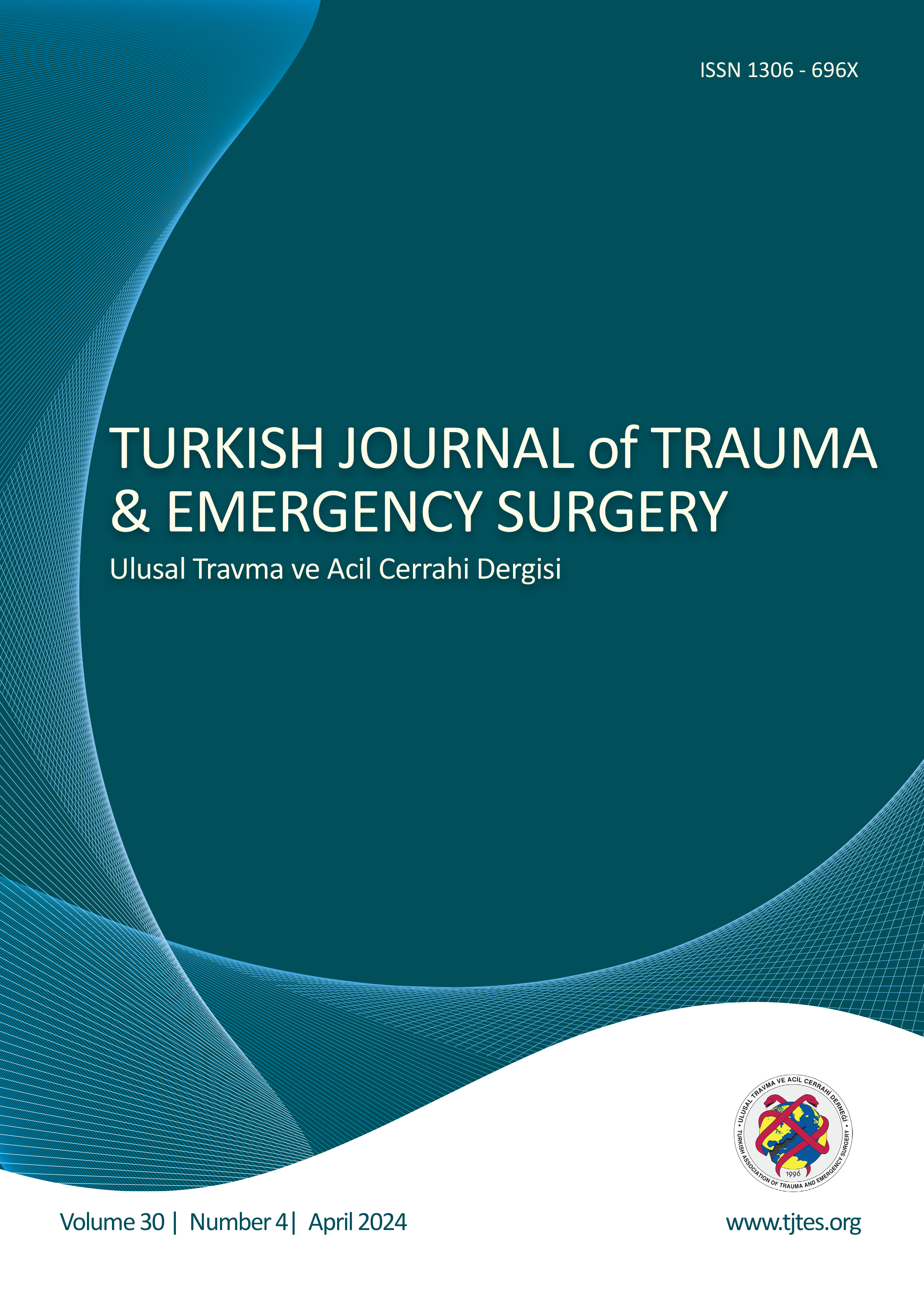Hızlı Arama
Geriatrik travma hastalarında mortalite tahmini
Aynur Yurtseven, Afşin Emre KayıpmazAnkara Etlik Şehir HastanesiAMAÇ: Modifiye 5 faktörlü kırılganlık indeksinin (mFI-5) geriatrik hastalarda tedavi sonrası gelişebilecek komplikasyonları öngörmede kullanılabileceği gösterilmiştir. Ancak çoklu travmalarda mFI-5'i diğer travma skorlama sistemleri ile karşılaştıran yeterli çalışma bulunmamaktadır. Bu çalışmanın amacı, geriatrik travma hastalarında mFI-5, yaralanma şiddeti skoru (ISS) ve geriatrik travma sonuç skorunun (GTO) mortalite ile ilişkisini belirlemektir.
GEREÇ VE YÖNTEM: Bu retrospektif gözlemsel çalışmada, üçüncü basamak bir hastanenin acil travma alanına başvuran 65 yaş ve üzeri hastalar değerlendirildi. Laboratuvar parametreleri, görüntüleme sonuçları, kan replasmanı, hastanede yatış durumu, yoğun bakım takibi, ameliyat durumu, ISS, GTOS, mFI-5 skorları ve mortalite sonuçları kaydedildi.
BULGULAR: Çalışmaya toplam 241 hasta dahil edildi. Ortalama yaş 78.12 (±8.34) yıldı. Travma kaynağı çoğunlukla düşmeye bağlıydı (n=142, %58.9). En sık torasik yaralanma gözlendi (n=86, %53.7). Kabulden sonraki ilk 24 saat içindeki mortalite için ISS (14.1 ila 26.33), GTOS (119.02 ila 157.33) ve mFI-5 (2.53 ila 3.33) skorları anlamlı derecede yüksekti (p değeri sırasıyla, 0.001, 0.001 ve 0.017). Benzer sonuçlar bir aylık ve üç aylık mortalite için de gözlendi (tüm analizler için p değeri 0.001'di).
SONUÇ: Skorlama sistemleri erken mortalite tahmini için hayati öneme sahiptir. ISS, GTOS ve mFI-5 skorlamaları, geriatrik travma hastalarında komorbiditeleri, yoğun bakım ünitesine yatışı ve mortalite oranını tahmin etmede benzer sonuçlar göstermiştir. ISS puanlaması karmaşık bir formülasyonla hesaplanır. Aynı şekilde, GTOS özellikle geriatrik hastalar için tasarlanmıştır ancak ISS üzerinde yeni ek hesaplamalar gerektirir. mFI-5, hesaplanması kolay olduğu için acil servislerde kullanımı faydalı olabilir.
Mortality prediction in geriatric patients with multiple trauma presenting by ambulance
Aynur Yurtseven, Afşin Emre KayıpmazDepartment of Emergency Medicine, Etlik State Hospital Faculty of Health Sciences, Ankara-TürkiyeBACKGROUND: The Modified 5-Factor Frailty Index (mFI-5) has been shown to predict complications following treatment in geriatric patients. However, few studies have compared the mFI-5 with other trauma scoring systems in cases involving multiple injuries. This study aimed to evaluate the Relationship Between mFI-5, Injury Severity Score (ISS), and Geriatric Trauma Outcome Score (GTOS) and their association with mortality in geriatric trauma patients.
METHODS: This retrospective cohort study included patients aged 65 and older who were admitted to the emergency trauma unit of a tertiary care hospital. Data collected included laboratory parameters, imaging results, blood transfusion requirements, hospitalization status, intensive care unit admission, surgical intervention, ISS, GTOS, mFI-5 scores, and mortality outcomes.
RESULTS: A total of 241 patients were included, with a mean age of 78.12 (±8.34) years. Falls were the most common cause of trauma (n=142, 58.9%). Thoracic injuries were the most frequently observed (n=86, 53.7%). Patients who died within the first 24 hours of admission had significantly higher ISS (14.1 vs. 26.33), GTOS (119.02 vs. 157.33), and mFI-5 (2.53 vs. 3.33) scores (p=0.001, p=0.001, and p=0.017, respectively). Similar trends were noted for one-month and three-month mortality (p=0.001 for all).
CONCLUSION: Scoring systems are essential for early mortality prediction in geriatric trauma patients. ISS, GTOS, and mFI-5 scores have shown similar effectiveness in predicting comorbidities, intensive care unit admission, and mortality in geriatric trauma patients. ISS involves a complex calculation, while GTOS, although specifically designed for geriatric patients, requires additional computations based on the ISS. In contrast, mFI-5 may be more practical in emergency settings because it is easy to calculate.
Makale Dili: İngilizce




